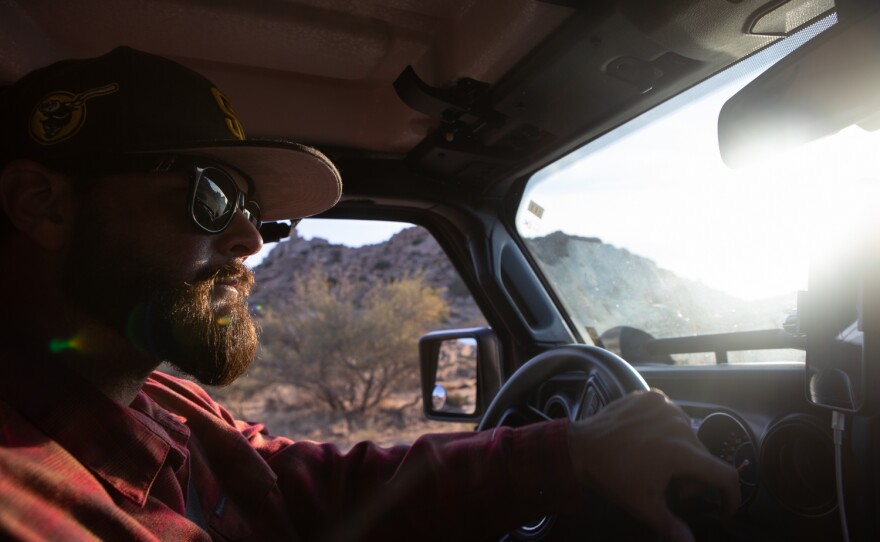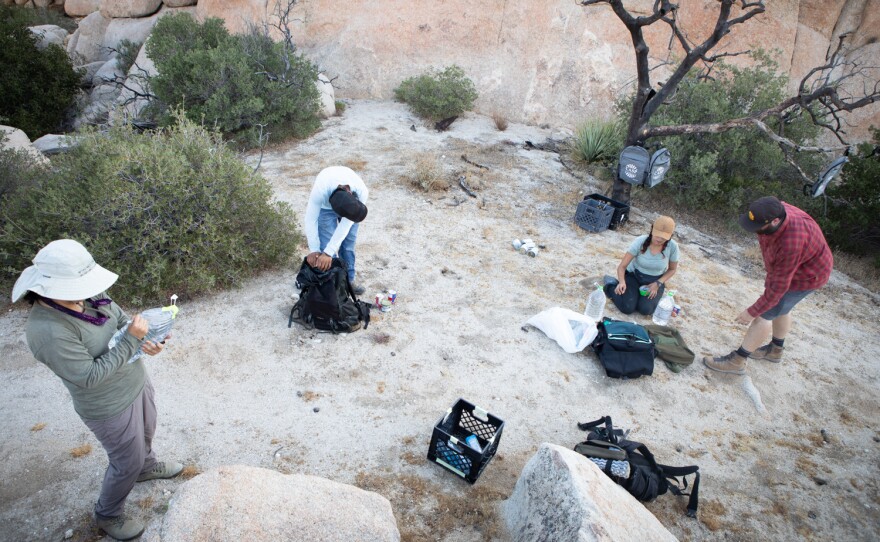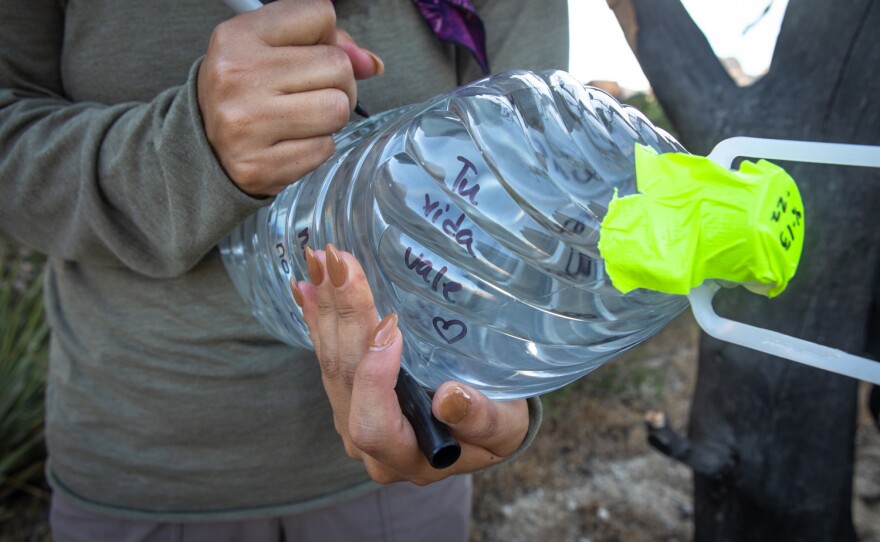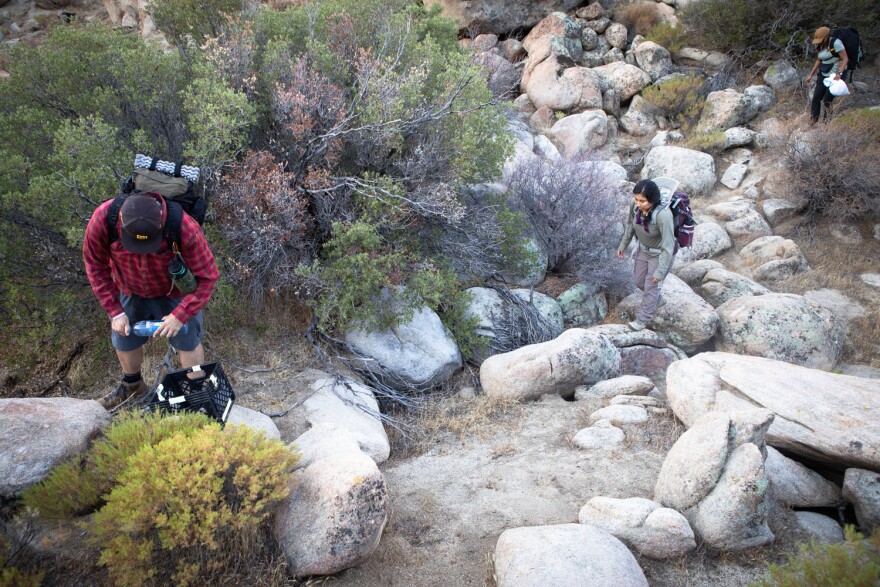“Desconocido/a.”
The engraving on a heart-shaped plaque posted on a yellow wooden cross stands out in the landscape of rocky hills and shrubs. There’s half a dozen of them across California's borderlands.
James Cordero, who leads a group of volunteers to stock water, food and other supplies along migrant corridors, plants the crosses to mark where someone has died in the vast desert expanse.
“The people will be unknown or forgotten, but we can honor them.”
Every year, the remains of migrants who succumbed to the environment in their attempt to enter the U.S. are recovered from California’s border strip. Border Patrol agents or aid workers stumble upon the bodies, sometimes days or weeks after the death.
Those deaths have long been a fact of life in the region, but recent data show Imperial County’s desert has become increasingly deadly in recent years.
Since 2018, at least 50 migrants have died in Imperial County while attempting to cross the border, according to Border Patrol data. More migrants died from 2018 to 2020 — the latest available data from the agency — than in the previous six years combined.
But those numbers don’t tell the whole story, according to immigration advocates and researchers. Incomplete reporting by Border Patrol and a high number of people reported missing but never found mean the death toll could be much larger.
Federal immigration enforcement has long driven migrants into risky terrain along the Southwest border through a policy known as “prevention through deterrence.” The idea is to discourage illegal entry into the U.S. by increasing enforcement in more urban areas, leaving remote and dangerous border regions as the only remaining crossing corridors.
But opponents say the policy hasn’t stopped people from crossing –– it’s only made it more deadly.
“There is nothing we can do with the U.S.-Mexico border to slow down the flow of these incredibly desperate people,” said Jason De León, a UCLA anthropologist who studies Latin American migration. “They will continue to come. They will continue to die as long as this policy is in place.”

Increasing border enforcement, climate change and shifting migration patterns could bring even more deaths along California’s southern border. Customs and Border Protection has taken steps to reduce deaths, but researchers, including De León, are skeptical.
“This problem is not going away anytime soon,” said De León, author of “The Land of Open Graves: Living and Dying on the Migrant Trail,” an anthropological analysis of exposure deaths among migrants in the Sonoran Desert of Arizona.
“And we're seeing it happening, getting worse as we're watching it.”
Migrant deaths on the rise
The 71 miles along Imperial County’s southern border was once the deadliest region for migrants attempting to cross into the U.S. between ports of entry, according to data collected by Border Patrol.
In 2001, nearly 100 migrants died in the El Centro sector — the Border Patrol area covering Imperial County — the most of any sector along the southwest border.
Over the next 20 years, that number fell dramatically, along with Title 8 apprehensions — instances when Border Patrol finds someone believed to be in the U.S. without permission.
Two decades of migrant death and apprehension data analyzed by inewsource indicates when more people try to cross in the El Centro sector, more of them die.
California, once a primary crossing corridor according to De León, sees far fewer apprehensions today than other sectors along the border such as Yuma and the Rio Grande Valley. But that could be changing.
“People are constantly finding new holes,” De León said. ”Now you’re seeing a movement back to California.”
And if the pattern from 20 years of data stays true, that could mean more deaths.
Between 2018 and 2020, migrant deaths along the border in the El Centro Sector jumped compared to years before.
The Mexican Consulate of Calexico, which keeps records on the death of its citizens in the U.S., also tracked an upward trend in exposure deaths along the border strip in Imperial County around the same time frame.
In 2021, the Consulate reported 14 exposure deaths among its citizens and five so far this year.
Customs and Border Protection, which houses Border Patrol, did not provide a sector breakdown of migrant deaths for fiscal year 2021, which starts in October, or 2022 to date. But the agency did report 151 migrant deaths across the entire border for 2021.
The San Diego Sector also saw a slight uptick in deaths recently. Border Patrol reported 13 deaths in the area in 2020, while the previous eight years saw below double-digit deaths.

Still, records kept by government agencies could be obscuring the true death toll.
The death tallies don’t account for the hundreds of people who have gone missing along the U.S.-Mexico border just this year, according to data from the International Organization for Migration’s Missing Migrants Project.
The project has reported 283 dead or missing migrants along the border so far in 2022.
Border Patrol’s response
Immigration advocates have also long suspected that official counts from governmental agencies downplay the deadly reality of border crossing. A recent report from the Government Accountability Office confirmed those suspicions this April.
In data reported for 2015 through 2019, Customs and Border Protection omitted some deaths discovered by outside entities, such as local law enforcement, according to the GAO report.
Customs and Border Protection is required to report numbers on migrant deaths along the border by both a directive from Congress that accompanied the 2020 Department of Homeland Security Appropriations bill and a federal law called the Missing Persons and Unidentified Remains Act.
That law also requires the agency to deploy rescue beacons to reduce deaths in the southwest border region. The El Centro sector has 14 rescue beacons and warning signs through especially dangerous crossing points, according to agency spokespeople.
So far this year, Border Patrol conducted 353 search and rescue missions in the sector.

In response to the report’s findings, Border Patrol has agreed to include all deaths along the border in its future reporting. But data for previous years remains incomplete, making it difficult for the public, researchers and lawmakers to understand how border enforcement and policy is playing out.
“Documenting the number of bodies, the number of people who have died during this process is important so that we can have some accountability,” De León said.
Immigration advocates and researchers have long criticized the Border Patrol’s “prevention through deterrence” strategy, arguing it has been responsible for the deaths of thousands of migrants who died or disappeared in the desert after attempting to cross into the U.S.
The strategy is designed to increase the likelihood of apprehension in traditional smuggling routes and force migrants into “more hostile terrain, less suited for crossing and more suited for enforcement,” according to internal documents from 1994.
Increased use of surveillance technologies like drones and remote cameras push migrants into harsher terrain in an effort to avoid detection.
The environment itself, De León said, is used as an enforcement tool against migrants. And rising temperatures due to climate change could make them even more vulnerable to heat-related illnesses.
By 2050, Imperial County is expected to experience about 26 extreme heat days per year –– when the temperature exceeds the top 1% of hottest temperatures in the area historically, according to the National Integrated Heat Health Information System, a federal database measuring the impacts of global warming.
By that time, most days out of the year are expected to exceed 90 degrees.
Aid groups struggle to keep up with need
The signs of human travel are unmistakable in the desert: footprints in the sandy gravel, a discarded water bottle coated with dust, food wrappers, a cell phone, a single shoe.
Cordero and Jacqueline Arellano, who lead water drops in the desert with a nonprofit called Border Kindness, have a system to keep track of where migrants cross through the desert. In recent years, they’ve noticed migrant travel shift to adapt to border enforcement strategies.
High trafficked areas have dispersed across the desert. The group has expanded their drop sites further north and east, and the need for vital supplies has jumped.
Death data between 2015 and 2021 provided by the Imperial County sheriff, who also serves as coroner, showed people died in the county’s “open desert” as far north as Desert Shores on the Salton Sea and as far east as Winterhaven on the California-Arizona border.
The Imperial County data might not provide a complete picture of how frequently migrants have died in the desert there. Officials say they don’t track deaths of migrants, specifically, and the county’s numbers fall short of what Border Patrol has tracked.
“We're literally not able to keep enough water out there,” Arellano said. “The consumption is higher than we've ever seen it.”
The past two years the couple has been working harder than ever, leading volunteer groups that start in the predawn hours from March to November, then coming back home to care for their one-year-old.
They say they hike through triple degree heat with backpacks filled to the brim with water jugs and canned food, sometimes to the point of near exhaustion, because Arellano knows the consequences if they don’t make it out to the desert.
“That could cost somebody their life.”
-
We speak to Brenda Tracy, a rape survivor who SDSU brought in last fall to speak to male athletes amid allegations of a gang rape by members of the football team.









